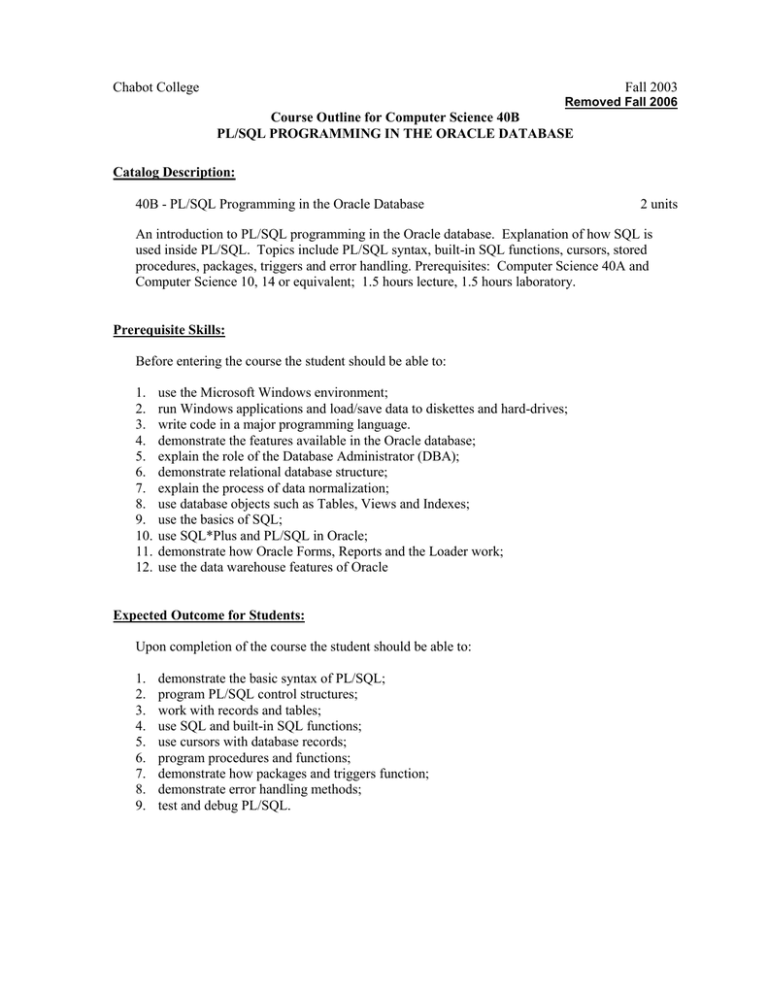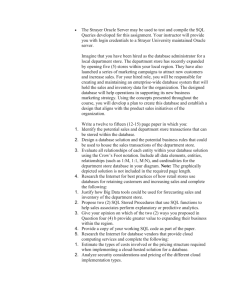Chabot College Fall 2003 40B - PL/SQL Programming in the Oracle Database
advertisement

Chabot College Fall 2003 Removed Fall 2006 Course Outline for Computer Science 40B PL/SQL PROGRAMMING IN THE ORACLE DATABASE Catalog Description: 40B - PL/SQL Programming in the Oracle Database 2 units An introduction to PL/SQL programming in the Oracle database. Explanation of how SQL is used inside PL/SQL. Topics include PL/SQL syntax, built-in SQL functions, cursors, stored procedures, packages, triggers and error handling. Prerequisites: Computer Science 40A and Computer Science 10, 14 or equivalent; 1.5 hours lecture, 1.5 hours laboratory. Prerequisite Skills: Before entering the course the student should be able to: 1. 2. 3. 4. 5. 6. 7. 8. 9. 10. 11. 12. use the Microsoft Windows environment; run Windows applications and load/save data to diskettes and hard-drives; write code in a major programming language. demonstrate the features available in the Oracle database; explain the role of the Database Administrator (DBA); demonstrate relational database structure; explain the process of data normalization; use database objects such as Tables, Views and Indexes; use the basics of SQL; use SQL*Plus and PL/SQL in Oracle; demonstrate how Oracle Forms, Reports and the Loader work; use the data warehouse features of Oracle Expected Outcome for Students: Upon completion of the course the student should be able to: 1. 2. 3. 4. 5. 6. 7. 8. 9. demonstrate the basic syntax of PL/SQL; program PL/SQL control structures; work with records and tables; use SQL and built-in SQL functions; use cursors with database records; program procedures and functions; demonstrate how packages and triggers function; demonstrate error handling methods; test and debug PL/SQL. Chabot College Course Outline for Computer Science 40B Fall 2003 Page 2 Course Content: 1. PL/SQL basics a. Overview of features b. Basic block structure c. Control structures d. Records and tables 2. Using SQL within PL/SQL a. Basic SQL b. Built-in SQL functions 3. Cursors a. Fetch loops b. Cursor variables 4. Subprograms a. Procedures and functions b. Dependencies 5. Packages and triggers 6. Error handling Methods of Presentation: 1. Lecture, discussion and classroom demonstrations. 2. Student use of appropriate computer laboratory. Assignments and Methods of Evaluating Student Progress 1. Typical Assignments a. Students will be asked to write and implement various and multiple assigned programs and other assignments that utilize all topics included above in the course of study. 2. Methods of evaluation a. Exams b. Quizzes c. Midterm and Final Exam Textbooks(s) (typical): Oracle9i PL/SQL Programming; Scott Urman, McGraw-Hill, 2001 Special Student Materials: Computer lab fee A. Oliver revised by J. Traugott 9/02





